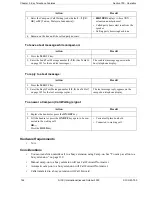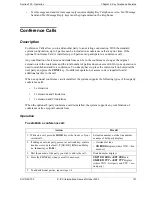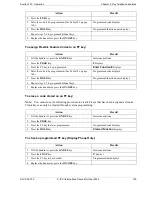
Section 700 - Operation
Chapter 5. Key Telephone Features
S-ICX-50-700
S-ICX (International) issued October 2000
149
•
When a fourth party is added, the conference is moved to a conference circuit on the 8-party
conference card. If an 8-party conference circuit is not available, a fourth party cannot be added
to a conference.
•
Once an 8-party conference circuit is used, it continues to be used as long as the conference
continues.
•
An 8-party conference card supports up to four 8-party conference circuits. However, the card
must be placed in cabinet slots 1, 5, or 9 to support more than one 8-party conference circuit (and
jumpered accordingly).
Directory Numbers
Description
A Directory Number (DN) allows extension numbers to be used on a key basis. The same DN may be
assigned to multiple keys on the same telephone and to keys on other telephones.
When a telephone’s extension number is assigned to a key on the same telephone, it is considered a
Primary Directory Number (PDN). Up to three appearances of the PDN may be assigned to keys on a
key telephone. This allows for multiple calls on the same DN.
When a DN is assigned to an FF key on another telephone, it is considered a Non-Primary Directory
Number (NPDN). Up to three NPDN appearances of the same DN may be assigned to keys on a
telephone. This allows calls to the DN to appear on multiple telephones. The calls ring in on a
specified basis - immediate, delayed, or no-ring.
A telephone may only have one PDN (on up to three keys) but may have multiple NPDNs with up to
three appearances of any one NPDN.
In Version 4.5 and higher, directory numbers may be assigned to stations that are not installed,
provided the cabinet is installed. However, once the directory numbers have been assigned to a
particular slot, that slot is no longer available.
















































